Image worship
1.1. In the Vishnudharmottara- purana, a text dated around sixth century AD, King Vajra earnestly seeks instructions from his teacher sage Markandeya, “how can one depict in an image, the Supreme Being who is devoid of form, smell and emotion; and destitute of sound and touch?” The sage explains ”the entire universe should be understood as the modification (vikriti) of the formless (prakriti) .The worship and meditation of the Supreme is possible for an ordinary being only when the formless is endowed with a form; and that form is full of significance “.
1.2. An image is a form which brings the mind to focus on abstraction. One should adopt the stage of abstraction that is nearest to him and which can help.
The image of a deity in the Indian tradition is a Bimba the reflection or Prathima the personification of the virtues, the glory and the attributes that one associates with the deity. It is explained that the Bimba like the reflection of the distant moon in a tranquil pool is the virtual image of one’s concept/ mental image of one’s deity; but it is not the god/deity itself. It is a suggestion or a pretext (nimitta) for the deity.
1.3. The worshipper is aware that the forms (murti), sounds (mantras) and diagrams (mandalas) employed in worship are human approximations and are inadequate representations of God (prathima svalpa buddhinaam). Yet, he finds through them an approach to the Supreme.
1.4. Sage Markandeya explains, the qualities that we admire in a divine being are within us. And, when we worship the images that personify such attributes, we awaken those divine aspects latent in us. When we are filled by that grace, there is no space left for base desires and pain; we have become that deity.
Iconography and symbolism
2.1. The polytheism gave tremendous impetus to all branches of Indian arts, literature and iconography. It provided for depiction and worship of divinity according to ones ideal in love, adoration and earnestness.
2.2. The Indian figurative art and Iconography, over the ages, succeeded in making a coherent use of images to represent abstraction; and to gracefully unite forms and ideas in a loving marriage. The image and its symbolisms are idioms of beauty grace and power nurtured and honed by generations of artists.
2.3. Indian code of symbols appears to have come from ancient times and its origins are lost in the mists of prehistory. It is based on the assumption that there exists a natural affinity between forms and ideas.
The Indian iconographic traditions have developed an elaborate set of idioms, phrases and symbolisms that give eloquent expression to the attributes, powers, and disposition of the gods and goddesses embodied in an image.
For instance:
- multiplicity of heads denotes presence of their concurrent abilities; and multiplicity of hands denotes their versatile abilities.
- The three heads of a divinity indicates trio guna (guna-triad: sattva, rajas and tamas) or shakthi traya [iccha (will), jnana (consciousness) and kriya (action) shakthi or powers].
- Four heads represent comprehension or enveloping four Vedas; or overseeing four directions.
- Five heads stand for five principles or elements (pancha-bhuthas) or five divine attributes or five stages of the evolutionary process.
[Shristi(creation), shthithi (expansion), samhara (withdrawal), triodhana (concealing) and anugraha (preserving till the commencement of the next cycle of evolution)]
The use of an animal icon would seek to represent particular abstract qualities associated with that animal such as wisdom, agility or power. Gestures (mudra) of the hand or the holding of a certain object (ayudha) are meant to articulate the deity’s powers, associations and dispositions.

Not all divine representations are made through icons. Shiva is represented usually by a conic Linga or an un-carved rock; Vishnu and Narasimha are worshipped at homes as Saligrama (a special types of smooth dark stones found on bed of the Gandaki river); Ganapathi is best worshipped in the roots of the arka plant, and he is also represented by red stones (sona shila) or turmeric cones or pieces (haridra churna). The Devi in Kamakhya temple is worshipped in a natural fissure of a rock. Yet, all these divinities have specified well defined iconographic forms.
Iconography of Vishnu image
3.1. As regards Vishnu, one of the most popularly worshipped gods in the Hindu pantheon, the iconographic features of his image are discussed in detail in a large number of texts of the Vaikhanasa and Pancharatra traditions. The texts of the shilpa sastra have also prescribed with great care and diligence the iconographic features of Vishnu images of various forms. Among the Vishnu-oriented Shilpa texts, the 5th -6th century texts Brahmiya Chitra Karma Shastram, Rupamandana and Vishnudharmottara purana are the prominent ones. There are in addition, numerous Dhyana-slokas, or word-pictures in verse that present graphic details of the form, substance and attributes of the murti. These verses are meant for contemplation and guidance of the Shilpi, the sculptor.
3.2. Vishnudaharmottara – Chapter 44. 9-13 specifies that one should make Vishnu, the God of gods, seated on Garuda, with the bosom shining with the Kaustubha (jewel), wearing all ornaments, resembling in color the water-laden cloud; and clothed in a blue and beautiful garment. Four faces should be made ; and arms twice that. The Eastern face is called Soumya (placid), the Southern Narasimha (man-lion), the Western Kapila and the Northern Varaha (boar-like). Vishnu wears Vanamala (long garland of flowers), and in his right hands (should be shown) an arrow, a rosary, a club and so forth, and OH great king, in his left hands should be shown a skin, a garment, and a bow.
-
- Deva-Devam tattha Vishnum karaye Garuda-sthitham // 9//
- Kausthubho -udbhavitoraskam , sarva-abharana -dharinam /
- sajala-ambuda-sa-chhayam , pita-divyambaram tattha //10//
- Mukhas-cha karya chatvaro bahuvo ,dvi-gunas tattha /
- Soumyan -to vadanam Purvam , Narashimhantu-Dakshinam /11//
- Kapilam Paschimam vaktram , tattha Varaham-Uttaram /
- Tasya Dakshina-hastheshu baanaksha musula -ayudham //12//
- Charma-cherum Dhanush-Indra-chapeshu vana-malinam //13//


3.3. A concise picture of the Vishnu-image is also presented in Gopala-uttara-tapini-upanishad (45-48): His feet bear the auspicious signs of a celestial standard, a royal parasol. His chest is adorned by srivatsa locks of hair, the brilliantly shining kaustubha gem and rows of forest-flower garlands (vanamala). His four hands hold shankha (conch), chakra (discus), gada (mace) and padma (lotus).He is adorned with armlets, garlands, jewels, diadem and earrings shaped like makara the sea monster (makara-kundala).

His form is enchanting and auspicious (divya mangala vigraha); radiant like the sharad -full moon ; his eyes glow like blue lotus blossoming amidst the pool of clear water ; his brows like a well strung bow; his nose slender and shapely like the petals of champak flower ; the serene, cool, gentle smile, pure like cow’s milk , dancing on his full and well shaped red lips lights up the whole world ; his chin firm and well proportioned; his throat bright and sound shaped like a conch; the tilaka adorning his forehead between the brows is luminous like crescent moon in a clear cloudless sky; his arms long , strong and supple like the elephant’s trunk; his chest wide , strong and healthy; he is adorned with golden-hue–silk garments (pitambara);he is richly and tastefully ornamented; and he is the very embodiment of all the grace , beauty and joy in the universe.
3.3. The most common representations of Vishnu are as standing (sthanaka) in sama-bhanga on a lotus-pedestal (padma); or as seated (asana) relaxed and comfortable.
He is also represented as Yoga-Narayana seated in yogic posture on a pedestal of white lotus.
The other most common depiction of Vishnu is as reclining (shayana) on the coils of Sesha the serpent with multiple heads. There are variations in his shayana attitudes
(Please click here for details)

Vishnu tattva, the essence

4.1. Vishnu is the middle one of the Hindu Trinity –Brahma, Vishnu and Shiva. Each of the Trinity is associated with one of the three states of consciousness and three states of relative conditions (guna).
4.2. Brahma is the wakeful state (jagrat); Vishnu is the vision of the dream (svapna); and Shiva is experienced in dreamless-sleep (sushupti).It is said the knowledge of outward forms is obtained in wakeful state; knowledge of inner principles is obtained in states of mental-vision which is the dream state; while the perception of the formless reality is gained in absolute stillness, the complete silence of mind.
4.3. Among the gunas, Vishnu represents sattva guna which is cohesion. It is a centripetal tendency; it stays at the centre and draws all things towards it. All that is in the universe tends towards a centre, towards cohesion, towards existence, towards light and truth. Vishnu is the inner cause, the power by which things exist and are held together. Vishnu is the centre of the universe towards which everything tends. Vishnu represents that sattva tendency.
4.4. The Vishnu image symbolizes his attributes as one who dwells in everything and in whom everything dwells; one who defeats the power of destruction and who overcomes all; one who preserves , protects and the pervades all existence.
Symbolisms in Vishnu image
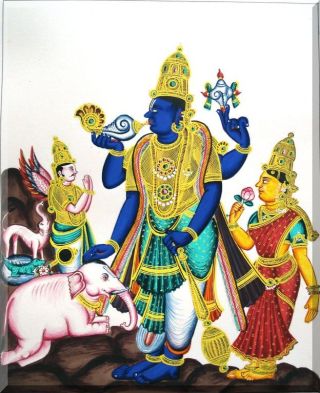
5.1. The image of Vishnu is a group of symbols; its every aspect, attribute and ornamentation is of significance and is intended as an object of worship and adoration. The symbols and symbolisms associated with the Vishnu image coherently present him as the Supreme Being who pervades and protects the universe.
Let’s see how those symbolisms are built into the Vishnu image.
5.2. Colour
Vishnu is always represented as dark blue like a rain-bearing cloud (neela megha-shyama) or blue like clear sky – (Indra-nila , azure sky-blue as that of sapphire or emerald ) – the infinite, formless, pervasive substance of spatial universe, symbolizing his nature of limitless brilliance that pervades all universes.
Though Vishnu is represented dark, his associates are in different colours; each according to his/her disposition. Vishnu presents a multi-coloured splendour.
His consort Lakshmi is glowing like molten gold (tapta kanchana sannibha); Bhudevi , his other consort, is of the colour of acacia flower; Garuda , his ride, is white; Sesha the serpent on which he reclines is dark like a cloud; the conch (shankha ) in his hand has the mellow brightness of the full moon; the discus (chakra) is shining brilliant like the sun; the mace (gada) is dark; the lotus (padma) is fresh bright and enchanting; the kaustubha jewel on his chest sparkles in the colour of dawn; srivatsa the lock of hair on his chest is like jasmine flower; the rows of forest flower garlands that swing across his chest are of five colours; and the arrows he holds are like lightening (Garuda purana 1.11)
5.3. Four Arms

Four arms represent the fulfilment of manifestations in all spheres of life. They symbolize domain over four directions of space and thus the absolute power over all universe.
In the case of Vishnu, the four arms are also said to represent three fundamental functions or tendencies [creative tendency (shristi), cohesive tendency (sthithi); and , dispersion and liberation (laya)] and fourth being the notion of individual-existence (ahamkara) from which all individualized forms arise.

5.4. Four Ayudhas
Vishnu in each of his four hands holds an ayudha, an attribute: shankha (conch), chakra (discus), gada (mace) and padma (lotus).
Shankha
The Shankha, conch, is the symbol of the origin of existence. It is associated with water the first element, the source of all life. It has the form of multiple spirals evolving from a point to ever increasing spheres. When blown, it produces a sound associated with the primal sound from which creation expanded. Shankha represents the creative (shristi) aspect of Vishnu.

Shanku in Philadelphia Museum of Arts
The Shankha that Vishnu holds is named pancha-janya, born of five; and it represents the pure-notion of individual existence (sattvika ahamkara) from which evolved the principles of five elements (bhutas).
Chakra

The discus Sudarshana-chakra, beauteous to behold has six spokes equivalent to six petals of a lotus. Its nature is to revolve. It represents the universal mind, the will to multiply. (Vishnu purana 1-22-68). Chakra represents the cohesive (sthithi) aspect of Vishnu.
The chakra is in the design of a wheel. The wheel is symbolic of life, ever –renewing itself in a cycle of time. The wheel of radiance symbolizes the Sun. Its six spokes represent the six seasons, the six cycles of the year. The nave, in which the spokes are set, the centre, represents changeless and motionless reality .The spin of the wheel creates the illusion of duality, the Maya.

The Chakra corresponds to the active notion of the individual existence (Rajas-ahamkara); and is associated with the fire principle.
The early representations of chakra were large in size forming a halo behind Vishnu’s head. The chakra was later stylized into a small ornamental ayudha held gracefully with two fingers.
Gada

The gada, mace, named Kaumudiki is that which dazzles and intoxicates the mind. It is called the stupefier of the mind (Vishnu purana 1.22.69).The mace in Vishnu’s hands is the symbol of primal knowledge (adya-vidya).
The mace Kaumudiki is often referred to as the female, the dazzler who destroys all that opposes it. Kaumudiki is compared to Kali the power of time. Nothing can conquer the time. (Krishna Upanishad -23)
Padma

The Lotus, the immaculate flower rising from the depths of water, ever remote from the shore and unfolding in all its glory represents the evolving universe, the expansion of creation. It evolves from the formless endlessness of casual waters.
The lotus is the symbol of purity, spiritual wealth, abundance, growth and fertility. It is sometimes taken as the emblem of six transcendental powers (bhaga: jnana, shakthi, bala, aishvarya, virya and tejas) which characterizes divinity (bhaga-van).
The lotus is associated with the notion of purity and cohesive tendency (sattva) from which springs Dharma and jnana.
5.5. Bow, arrows and quiver
The Vishnu image is at times endowed with a bow and a set of arrows. His bow is Saranga; and hence he is Saranga-pani the one who holds the saranga. The bow targets the distant and the unknown. In the Vishnu imagery, the bow is the instrument through which feelers are sent into the unknown spheres of illusory creation.
Bow is the destructive aspect of the notion of individual existence (tamasa ahamkara). This aspect is associated with the disintegrating tendency (laya) and is the origin of sensory perception. The bow therefore corresponds to the power of duality (maya) (Vishnu purana 1-22-70)
The arrows of Vishnu are the senses, the fields of activity of the intellect (Vishnu purana 1.22-73).
The quiver is the store house of actions.
5.6. Sword and the sheath
The sharp and blazing sword Nandaka (source of joy) represents sharp incisive intellect whose substance is wisdom (vidya) (Vishnu purana 1.22-74). The flaming sword is the powerful weapon which destroys ignorance.
The sheath which holds –hides the sword of knowledge is avidya. It represents darkness which is also an attribute of the divinity. The sword shines forth when it is drawn out of the sheath.
5.7. Kaustubha
On the chest of Vishnu shines a brilliant gem Kaustubha, the treasure of the ocean. The Jewel represents consciousness, which manifests itself in all that shines: the sun, the moon, the fire and the speech. The splendorous jewel Kaustubha represents consciousness, the consciousness of all living things. It is the enjoyer of all creation.
5.8. Srivatsa
Srivatsa (the beloved of Sri) is often mentioned along with Kaustubha. But unlike Kaustubha, Srivatsa is not a gem or an ornament. It is a mark on his body. It is, in fact, a lock of hair situated on his right chest (vakshasthala sthitha), curling towards the right. Its colour resembles that of the jasmine; (shukla varna dakshinavarta romavali) .Vishnu is thus Srivatsankita, the one who bears the sign of Srivatsa. It is said to symbolize Vishnu’s yogic powers (yoga shakthi). It also represents the source of the natural world, the basic nature (pradhana).

In the earlier depictions of the Vishnu image, Srivatsa was indicated as a small sized triangle (in the form of three leaves) on his right chest. In the images of the latter periods, Srivatsa is in the form of small-sized Lakshmi (Vyuha – LakshmI) with two arms. Some say, it is meant to suggest that in this form, the jagrat state, Lakshmi the energy, is differentiated from Vishnu (the Purusha).
[Interestingly, the Srivatsa sign also adores the images of the Jain Thirthankaras and of the Buddha as well.]
5.9. Vanamala
Vanamala is the garland of five rows of forest flowers of different hues, hanging around the throat of Vishnu. Vaijayanthi (garland of victory) is a garland of five rows of jewels or five elements (bhuthas) that also adorns Vishnu.
According to yoga theory, the throat is the seat of Vishuddha chakra –the centre of extreme purity- which symbolizes pure consciousness, and creativity. It is the centre associated with the faculty of higher discrimination; and with the formless space. Throat is also the centre where pashyanti vak the formless speech manifests as audible sound (sabda). The garlands around the throat of Vishnu symbolize the display of manifestation (of duality) surrounding the formless nirguna. Vanamala is Vishnu-maya, the power of illusion of one who pervades all existence.
5.10. Garuda
Garuda, the golden eagle (suparna) is represented as a half -human and half- bird of immense size and strength, equal in splendour to Agni. Vishnu rides Garuda in his jagrat (wakeful) state, after the creative-process is set in motion.
Garuda means wings of speech, ‘whose wings transport from one word to another with the speed of light’. Garuda as three Vedas carries Vishnu the Yajna-pathi, with Rig (rhythm); Sama (sound); and Yajur (substance) all of which are elements of speech as also the ritual.


the son of Kashyapa (vision) is hailed as personification of courage. ‘The triad beautiful of the wing is courage itself, made into a bird ‘(shatapatha Brahmana: 6.7.2.6)
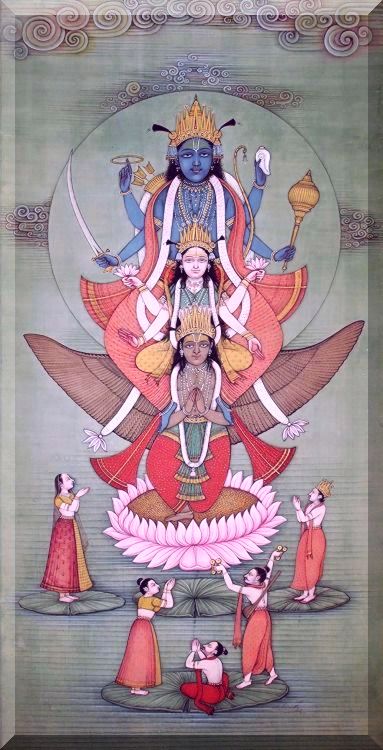
5.11. Sesha the Serpent
It is believed, when creation is withdrawn, the universe does not totally cease or is it wiped out. The universe that was destroyed persists in a subtle form as a reminder of what once was; and as a germ of what will be the next universe. That potent reminder (Sesha) of the destroyed universe is embodied in Sesha the serpent coiled itself and floating upon limitless ocean of casual waters.

Sesha, the primordial serpent, whose other name is Anantha, represents the non-evolved form of nature (prakrti).Vishnu sleeps in voga-nidra on Sesha floating on water, until he wills the next cycle of creation.
Anantha (the endlessness) is also the name of Vishnu. Some scholars say that Sesha (reminder) or Anantha is Vishnu himself in his potent state, as the universe that hibernates before the onset of the next cycle of evolution.
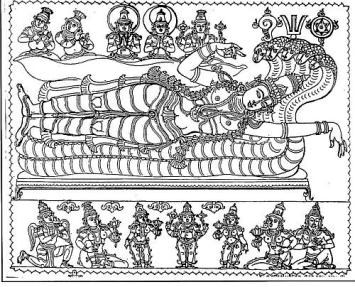
References and Sources
1 .Vishnudharmottara- purana –Part Three
2. Vishnu Kosa by Prof SK Ramachandra Rao
3. Gopala-uttara-tapini-upanishad
http://www.organiser.org/dynamic/modules.php?name=Content&pa=showpage&pid=295&page=24
4. The myths and gods of India by Alain Daniélou
5. The line drawings from Brahmiya Chitra Karma Shastram By Dr. G Gnanananda
And From Drdha Monge
The other pictures are from internet.
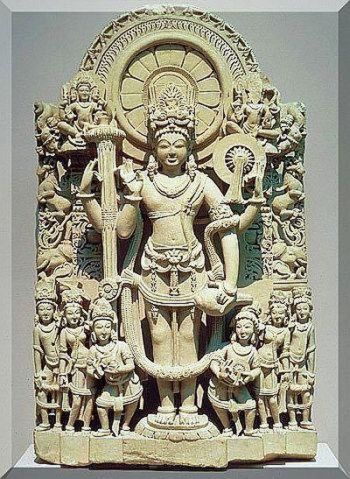


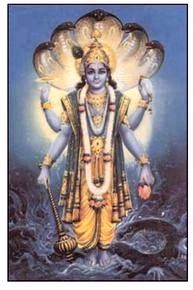
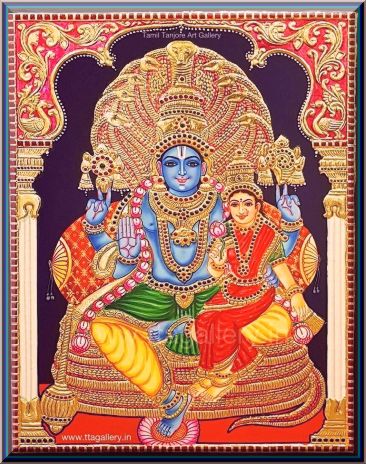





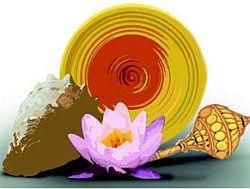
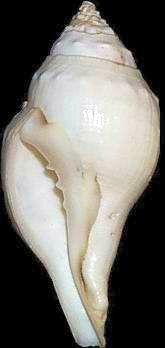


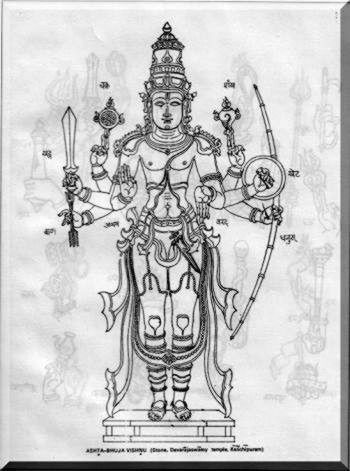



sreenivasaraos
March 19, 2015 at 6:21 am
i have seen chakrathalvar figure behind the sudarshana chakra..what does it mean?
i wonder what is the sigificance of the star which is also a jewish symbol.. ?
how come saligrma ,the yoni symbolism is attached to vishnu whereas the
linga symbolism to siva..
why is jagruta form of brahma has never taken root and the
dual aspcets of dtstruction and sustenenace have taken root in our psyche..??
some questions that occur to me…
lovely.enjoyed it thoroughly and makes some sense…
DSampath
sreenivasaraos
March 19, 2015 at 6:23 am
Dear Shri Sampath, Thank you. Sudarshana is not different from chakrathalvar. The Tamil name for Sudarshana is Chakrathazhvar or Chakrathalvar . Over a period of time Sudarshana the Chakra was personalized and designated as an Alwar; and was worshipped independently, that is separately from his Master Sriman Narayana. That was based in the faith that Sudarshana is endowed with powers to confer material wealth and properity; victory over ones’ enemies; and freedom from disease, pain and misery. In that context worship and prayers were offered to the icons of Sudarshana, which depicted Chakra on side and the personified image of Sudarshana on the other. You were, perhaps, referring to such icons.
Such images of Sudarshana are also employed in major temples as Bali-bera which receive food offerings on behalf of the attendant deities housed in the temple complex.
The Sudarshana image also leads the Lord’s procession towards the tank for a ceremonial bath (avabhrta-snana), at the conclusion of a major utsava. It is the first image to be immersed in the tank-water.
Please see the image below.
In the Tantra schools, Sudarshana Chakra is personified in a form of deity, usually with sixteen arms. He is shown as a powerful warrior standing amidst a six-cornered flame emitting star (chakra), in pratyaleadh posture (in a posture of movement). His complexion is red; his hair locks are formed by crowns of flames and his three eyes are golden. In his sixteen hands he holds disk, conch, noose, goad, club, axe, spear, stick, shataghni (fire emitting weapon with hundred pores), sword, spear, bow, arrow, thunderbolt, mace, pestle and trident. In this form he bestows boons of wealth, victory over enemies and freedom from disease. Please see the picture below.
The six spokes which form a star, represent the six seasons, the six cycles of the year (Ritu Sudarshana kala iti digbhandha—vishnusahasrana).Chakra the wheel is traditionally associated with Sun, the time and the cycle of life, all of which are indicative of movement and revolvolutions in a cycle.
Another interpretation is that Sudarshana is a manifestation of Sankarshana; and the six-angled figure (shat-kona) in which he stands illustrates the Vyuha ideology of his six divine attributes.
Yet another is that the six –cornered star represents six chakras: achakra; vichakra; suchakra; jwala-chakra; trailokya-raksha-chakra; and asurantaka-chakra.
(http://www.ramanuja.org/sv/bhakti/archives/aug97/0051.html)
I think the association of chakra with the concept of time appears simpler.
Since this response is getting lengthy , I shall respond to your other observations separately.
In the meantime, please keep talking.
Regards
sreenivasaraos
March 19, 2015 at 6:25 am
Dear Shri Sampath, I trust you read my earlier response relating to Sudarshana.
As regards Linga and Salagrama the distinctions are not as precise as one normally assumes .Though Salagrama-stone is taken as a visible representation of Vishnu, all Salagramas do not represent Vishnu; and not all those that represent Vishnu forms have cavities. The general belief is that smooth, small and dark colored Salagramas are to be preferred to the rough-surfaced, large and multiple colored ones.
There are also Salagramas that represent some forms of Shiva, of Shakti, of Surya, of Ganesha and of the Buddha. [The Siva-nabha-murti-salagrama is roundish like an elephant’s body; and in the central portion thick lines are seen. The Buddha-murti-salagrama has two apertures and two chakras in the interior.]
As regards associating Vishnu with female aspect, as you mentioned, I think you have a point. The three parts of the Shiva_linga, it is said, are associated with Brahma in the lower (hidden) part of the Linga; with Vishnu in the middle part covered by the pedestal (or yoni); and with Rudra in the top visible part. It is to the top, the Rudra-bhaga, the masculine part, that worship is offered. The Vishnu –bhaga is feminine and identified with Devi the jagad-dhatri, one who bears the world (yoni tu jagad-dhatri Vishnu swarupa).
In the iconographic representations of Hari-hara and Ardhanari, the right-half is Shiva and the left-half is Vishnu as Mohini, the feminine aspect.
You made a mention of Brahma, and as you remarked he represents the jagrat state which is duality. Though Brahma is associated with creation, he cannot be equated with the Creator of the Christian traditions. Because, Brahma does not seem to authorize, direct or control any process; and creation goes along, rather by itself, following the law of cause and effect, karma. As you know, worship involves faith and accepting someone without questioning.
In a way of speaking, we all of us are Brahmas, the un-worshipped gods. When you meet a person, you see only one of his faces, his other four are hidden. You see the face that he wishes to present to the world. His other faces are hidden from you: his intellectual side; his emotions; his memories and experiences which churn out his understanding and values; and his ego which seeks validation. We see the face that he presents but do not know to which one of his we are addressing.
Every Brahma that you meet is unique, some are intellectual and appreciate rational and evidence-based approach; some are emotional, they love when you open your heart and connect; some are attached to memories, to the past like fly in the ointment (or say Devdas) and are incapable of living in the present; and there are those for whom everything is about their ego, and talking to them is like walking on eggshells. Most people are a mixture of all the four, but most of the times you clearly see only one face. But beware; it is the other four hidden ones that ultimately decide how he connects to the world and to the persons around him.
Thank you for asking; and for your patience.
Please do read Dvarapalas and let me know.
Regards
sreenivasaraos
March 19, 2015 at 6:27 am
dear sreennivasarao,
let me offer my prostrations to you..
some things that you are saying are profound truths..
like the brahmas and the four faces of brahma..
in this regard what is the symbolism associated with the plucking of brahma’s head?
about saligrama..
it is amazing
have you written something ..on
these subjects ..any book..
i would love to read all your writings…
DSampath
sreenivasaraos
March 19, 2015 at 6:27 am
Dear Shri Sampath, that act of clipping a head was perhaps symbolic clipping of his inflated sense of ego.
No Sir, I have not published anything in print. Over the years, I used to write something or other occassionally just to take my mind off the day-to-day work and the drudgery. I kept that aside. The thought of publishing those jottings never crossed my mind. When I sometimes relooked at them, I could recognize that I was not saying anything new or precious; and not many would be interested in the stuff. I reckoned the world would learn to live on even if those hastily written notes did not see daylight. I was often tempted to destroy the old heap, but used to hold back saying ‘let me look at it once more’.
Some years back we shifted from Bombay; and I had to be away from Bombay at that time. When we later met in our home at Bangalore, my wife complained that she had a lot of trouble in getting the things packed; too many old and useless things. And she said she had to threw away many of those useless things including some old papers. When I heard that, it brought me a strange sort of relief.
Now, I occasionally post something or the other when someone asks me a question; and, which, understandably, not many, including the ones that asked the question, care to read. A luminous star in the Sulekha-horizon once called a ‘guy who writes about the dead that do not contradict’. When I come to think of that I reckon it is a rather fair assessment. If you say you liked reading what I have posted, that is because you are a very generous person.
Please keep talking.
Regards
sreenivasaraos
March 19, 2015 at 6:29 am
dear sreenivasa rao,
what you have added to me
only i know…
your knowledge
and wisdom i know
what i offer to the world is mostly what they know
not what i know..
i have met people who have invested on others irrespective of whether they get acknpwledged or not..you are one such person..
it breaks my heart to learn that
some one who did not know what you had to offer called you thus..
reminds me of the conversation
balrama or parasurama
had with rama
reminding him that
he was actualy vishnu come to the world with a purpose
he reminded him of his celestial duty
my brother knew the wonderful sloka associated with it..
i am not a generous person but i am perceptive
you belong to the tribe of sages
like my father who lived as a sage and died as one..
please document your thoughts in the for of
a book
if i read it many of my students will get benefited..
love and peace be with you
DSampath
sreenivasaraos
March 19, 2015 at 6:33 am
sree: yr blog is v thorough and informative
I need to revisit and absorb is thoroughly
but would love your thoughts on image of
shri vishnu on sesha in the kshir sagara
at times htis vision comes to me and am greatly attracted to it
but kanha resides in very pore of my being
want to understand what it means or what is the lord’s message
warm regards
bina
sreenivasaraos
March 19, 2015 at 6:33 am
Dear binagupta, You are truly blessed. Krishna and Vishnu are no different. Accept with Love the form that comes to you naturally; and which appeals to your inner core. Live in peace and joy. Thanks for the comment. Regards
sreenivasaraos
March 19, 2015 at 6:34 am
Dear Rao,
I have read only abridged versions of the 18 puranas – but whole detaoled version of Ramayana and Maha bharat.In the absence of Upanyasams as one of regular daily activity it is very nice that net provides from scholars like you more comprehensive information compiled ,grouped and presented.For reasons unknown due to legacy,roots and traditions imbibed on our minds there is a burning desire to know the thought processes of our fore fathers.These articles shed illumination and understanding of the past and a lot of real plans to create icons that can stand over centuries attracting the imagination of ordinary people ( the Bhakthas ) as source of Bhakthi sentiment and dharma.
Best wishes ,
N.K.Ravi.
sreenivasaraos
March 19, 2015 at 6:34 am
Dear Shri Ravi, Thank you. I am no scholar of any sort; I was just trying to answer a question as well as I could. I am delighted you if you found it useful.
Regards
sreenivasaraos
March 19, 2015 at 6:36 am
mr sreenivasarao sir, i read somewhere once that Adi Sesha, the serpent, incarnated himself as luxman in Ramayana to be near Sri Rama(another avatar of vishnu) to protect him. Is that true?
great blog… very educational !
thank you.
regds
vv
sreenivasaraos
March 19, 2015 at 6:36 am
Dear varu ven Thank you for the appreciation. Yes, as you mentioned Lakshmana just as Sankarshana (Bala-Rama) was regarded an aspect of Adi-Sesha.Wish you and your family a an auspicious and happy Navaratri.Regards
sreenivasaraos
March 19, 2015 at 6:38 am
Dear Mr Rao,
Very enlightening blog.
I am interested in Iconography of terra cotta temples of Bengal. I am currently reading a few books of Iconography od Siva . Search in the internet, specially in sulekha.com brought me to your writings.
I wonder if you would consider it worthwhile to create a domain of your own, where your writings will stand out.If you do so, I would like to be among your 1st visitors.
Before closing, I would like to know if you have studied Iconography of Ithyphallic Siva ( Lakulisha, Virupaksha temple of Pattadakal, Madhukesvara temple of Mukhalingam etc.) and have written anything on this subject ?
Best wishes.
Shyamal Chatterji
sreenivasaraos
March 19, 2015 at 6:38 am
Dear Shri Shyamal, Thank you for picking up an almost forgotten blog; and for the comments too.
I am not sure I have the skill and the resources to set up and run a website of my own. But, Apart from Sulekha, some other sites too regularly carry what I write even in case I do not send them the links. For instance, my friend Mrs.Harsha includes what I write in her site http://www.food-for-soul.net . Similarly, Indian Heritage site too carry most of what I wrote.
Yes, Indian Iconography interests me much. Though I have not written exclusively on Iconography, I do try, in variably, writing about the Iconographic aspects of the subject of the post. Among these, in my series on Devalaya Vastu _Temple architecture in Part Five (contd) and Part Six I have written in general about Temple Iconography. Please check the links. You may also please check the links on The Buddha Iconography ; Sri Dakshinamurthy Iconography; four posts on Vishnu starting with part One; and some others.
As regards the Terracotta temples of Bengal, I am fairly familiar; and I read some very well illustrated in Sulekha on the Terracotta temples at Bishnupur and other places posted by Shri Chanchal. But, I have not written on the Iconography in those temples.
In regard to temples at Pattadakal and elsewhere, no, I have not written on the Iconography in those temples. Instead, I tried covering some temples through their mural paintings. Please check my series on Legacy of Chitra Sutra. Please check starting from this list of blogs.
Please keep talking.
Regards
mskumar1994
January 24, 2021 at 9:06 am
Sir,
Thank you for this information. I recently came across this post when I was looking for details about why we represent Vishnu and other gods in such a manner. This cleared a lot of my doubts. I am surprised why this information is not commonly available in public.
—Siva
sreenivasaraos
January 24, 2021 at 5:35 pm
Dear Kumar
Thank you for the visit
You are welcome
Regards
Aditya
January 17, 2023 at 10:48 am
Thanks Sreenivasaji for this interesting piece. I see a difference in Vishnu’s iconography regarding the hand holding the Sudarshana. In some ancient sculptures(also in some of the images in this blog), its held in the left back hand while usually its in the right back hand. Do the shastras say anything about the position of Sudarshana.
Vishnu also seems to be different from other deities as it probably he is the only one who has close relationship with two different(and conflicting) animal forms. His vaahan is Garuda and he rests on Sesha. Would be happy to see a writing from you on Garuda & Sesha.